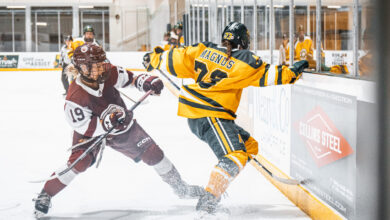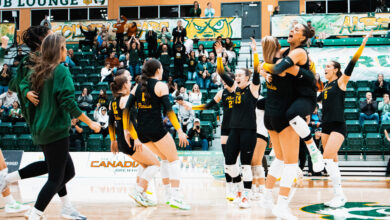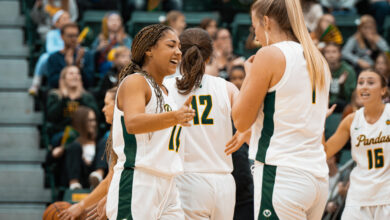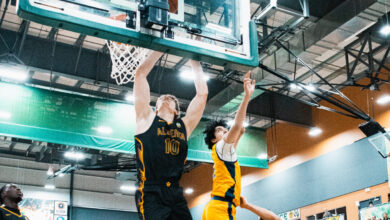Golden Bears recruitment still hopeful: “We don’t care what league they’re from”
U Sports has the chance to do something they haven't done in around 30 years — dive into different recruitment pools beyond the CHL.
 Fair Frames
Fair Frames U Sports has the chance to do something they haven’t done in around 30 years — dive into different recruitment pools beyond the Canadian Hockey League (CHL).
Is it ideal? Hardly.
Will they make it work? We’ll see.
In speaking with the University of Alberta Golden Bears’ general manager, Stan Marple, three things were made abundantly clear in this new sea of collegiate recruitment that universities must now navigate.
First, GMs will earn their pay check this summer.
Second, there are more leagues than Junior A that teams can, and should look at.
Third and most importantly, the league they come from might not be as important as the die hard — “we need the top goal scorer from the top team” — player, that some fans are looking for.
“I don’t really care where they’ve played before,” Marple stressed. “We want to try to find the best players available to complement our team.”
For the University of Alberta, University of New Brunswick (UNB), and several other U Sport schools, those players came in the form of first years, fresh out of the CHL, who dominated in a league where the difference between 21 and 25 is a little more subtle than 16 to 20. But you can even bring them in a little older.
Marple might not care per se where players come from, but every GM across Canadian universities will be looking at the American Hockey League (AHL) and ECHL to make up the difference in recruitment, thanks to a conveniently timed U Sports rule change, eliminating the need for players to red shirt a year before playing here.
This rule doesn’t self-correct recruitment entirely, but it makes it a more hopeful road to progress, less downward spiral towards subpar hockey.
“I think that’s a good rule. It allows for more players to be available,” Marple added while shedding light on the newer development. “It’s kind of opened up the market, so to speak, for those type of players.”
Even more, “U Sports is still going to find their players, just maybe initially not the pedigree that they normally would have,” according to former New Brunswick Reds head coach Gardiner MacDougall when the news initially broke.
Disgruntled and unsatisfied guys out of the pros might not be of the same “pedigree” as young hopefuls from the CHL, but they’ve matured, grown their game, and offer a different brand of hockey.
Of course, top players from Junior A — particularly ones who spent some time in major juniors — are still desirable, looked at a little less by the National Collegiate Athletic Association (NCAA), and needed to fill roster spots. Always have, always will.
So why not recruit hard, make the league slightly older, likely better, and a little more competitive.
“It’s making for a better brand of hockey for everybody — for the fans and for the players,” according to Marple.
Perhaps comparable to the NCAA?
“The NCAA isn’t really as stable. They have a portal where players and team management can put players in each year. So it’s really a year-to-year type league.”
All due respect to the destination league for collegiate hopefuls, but not all teams are created equal, and not all players wish to grind it out on a team that seldom makes it into the post-season when there are perfectly competitive teams north of the boarder looking south.
The message is made subtly clear if you don’t care what league they’re from: United States (U.S.) players are as open to Canada as Canadians are to them. Someone who went Junior A, preserved their NCAA eligibility, headed south, and now lost their spot or it isn’t working out.
Maybe even someone straight out of the U.S. development league — that’s interesting.
“Not only have they presented themselves, those are the type of players I’ve actively looked at,” according to Marple. “Perhaps guys that had good junior careers, and want to come to a school like ours.”
The Golden Bears, for reference, went 21-7-0 in conference. Mount Royal University had a program high of 22-6-0, excluding a thrilling five period overtime loss in their first national appearance. And UNB clinched the number one seeded, 28-1-1 record.
Aside from a small handful of teams left with limited options for recruitment while competing not only with the NCAA, but league best teams, there is a certain appeal to playing in Canada.
For one, the chances of making it into the post-season are higher. There are less schools, resulting in more attention to individual players. And if you end up at the right program, pro signings in Europe and North America are more common than the casual fan might give credit too.
“There’s lots of U Sports schools that would be better than some of the NCAA schools. Whether it’s the total hockey experience or a combination of hockey and academics,” MacDougall added.
Just as guys in the AHL or ECHL decide to look at U Sports, so too might someone from the NCAA who realizes the opportunities that come from programs like the Bears or Reds.
“I would just say that all the teams are doing a good job of recruiting, and it’s making the league more competitive,” Marple added.




